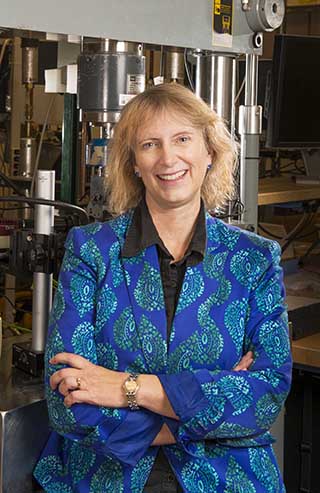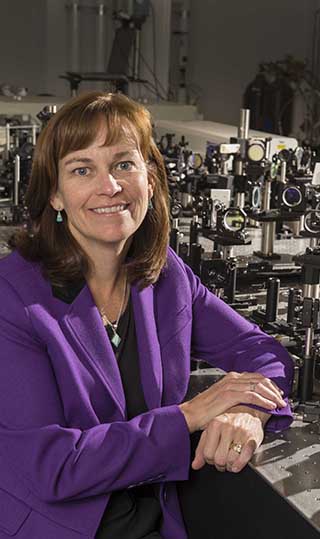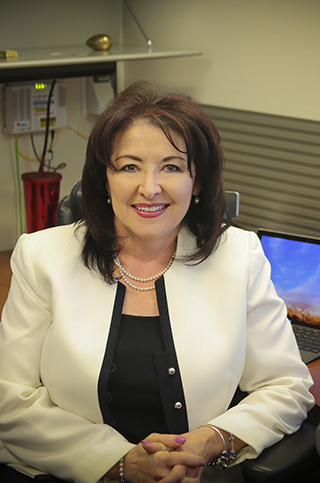Trio of Sandia women recognized as leaders in STEM, diversity

Three Sandia women have received a Women Worth Watching award, presented by Profiles in Diversity Journal.
Chemical engineers Carol Adkins and Justine Johannes each received a Women Worth Watching in STEM award and were profiled in a recent special STEM (science, technology, engineering, and math) edition of the journal. Carol is director of New Mexico Energy and Geoscience Center 8800 and Justine is director of Stockpile and Weapon Product Realization Center 6600.
“Collectively, these leaders are breaking barriers for women in STEM careers and we are honored to recognize them as well as the companies supporting them,” said publisher James R. Rector. “Supporting women in STEM is an essential part of a worldwide strategy to innovate, educate, and build a more connected world.”
Sandia Chief Diversity Officer Esther Hernandez was named a Women Worth Watching recipient as part of the magazine’s annual awards and will be profiled in the upcoming summer edition.
“Each year, we are extremely encouraged by the number of organizations in every sector that support the career advancement of women in their workplaces,” Rector said. “We have also been proud to provide an award with such meaningful impact on the movement for gender equity in workforce leadership.”
The award has recognized leading women executives for 16 years.

Carol Adkins
As Center 8800 director, Carol oversees Sandia’s solar, wind, hydro, grid, nuclear, and fossil energy programs for DOE.
Throughout her almost 30 years at the Labs in various positions and fields, Carol says she has seen fewer women in her current field of renewable energy. “I see it particularly in the wind industry. If there are 500 men at a meeting, I estimate there may be only five women,” she says.
Those numbers are not surprising to Carol. She attended the University of New Mexico, where she received a bachelor of science degree in chemical engineering. She went on to earn a doctorate in chemical engineering from the California Institute of Technology. “There were 15 students in my undergrad program and only two or three of them were female. At Caltech there were twice as many students in my year but the number of women stayed the same,” she says.
Carol says she believes that with continued efforts to encourage and support women and girls at every level and by raising awareness about how science and engineering can improve people’s lives, women will advance in STEM.
“I entered my technical profession very conscious of my unique position as a woman and I learned to survive and thrive by behaving like the majority demographic, the white males with whom I worked,” she says. “Constantly left out of the ‘boys’ club,’ I learned to make my own networks and support the women around me.”
In 1987, she was hired by a female manager and she does not take for granted the position she is in now — to hire the most qualified and technically proficient professionals in their fields, regardless of gender, “to make sure we reach out broadly,” she says.
“I would like to see small, steady increases in the number of women in STEM. Making major institutional and cultural changes too quickly risks sustained progress, but if we can all keep the big picture in mind while we take small actions in our spheres of influence, we can move forward collectively,” she says.
Carol is a mentor to a Caltech female graduate and numerous Sandia women. In 2015, she was named a UNM Distinguished Alumna of the School of Engineering.

Justine Johannes
Justine, director of Center 6600, has always been uncomfortable with the idea of being recognized as a woman in STEM, preferring to be judged solely for her technical contributions.
“As I have gained experience, though, I have softened that position. I recognize the benefit of celebrating all types of successes. I was flattered to be acknowledged as a woman making technical contributions while also celebrating a growing peer group of women in STEM,” she says.
To close the gender gap in STEM fields, Justine says two important issues must be addressed. The first, she says, is keeping girls engaged in math and sciences in kindergarten through 12th grade. “It’s hard for them to move into STEM fields if they don’t have a sufficient background to be successful,” she says. Second, she says, it is vital to reach a tipping point where young girls see themselves as having peers and a community of women to engage in their jobs.
“I’m a big believer in helping to create a sense of community among the women in an organization so they can support each other,” Justine says.
While serving in a previous position as the director of engineering sciences, she saw the number of women in management positions nearly triple. “I believe a big part of this change was a sense of community that was created,” she says.
Justine says she expects the number of women in STEM fields to continue to increase, and hopes to see more women in engineering fields typically dominated by men.
“When you focus specifically on women in STEM, studies have indicated that women are significantly motivated by their ability to contribute to the wellbeing of society. I’ve experienced firsthand the technical contributions Sandia makes to our nation’s security; they are incredibly compelling and provide an opportunity to contribute to society.”
Earlier this year, Justine was one of five alumni to receive the Distinguished Graduate Award from Cockrell School of Engineering at the University of Texas at Austin. Of the honor, Justine says, “Ultimately, I would not have been given this award without Sandia’s support of academic partnerships. The ability to work with universities to conduct research and attract talent enabled me to stay connected to the university long after I had graduated.”

Esther Hernandez
Esther (3010) works tirelessly to ensure Sandia Labs remains a place where building a diverse workforce and inclusive environment are top priorities.
“Very early in my career, I recognized the significance that the work environment plays in engaging employees as we come to work each day. I had jobs in which I truly felt like I was part of something important, and that energized me. I have also had some jobs where it was difficult to bring my full self into work every day,” Esther says. “I didn’t feel focused and creative.”
Even with the right environment, becoming a leader did not happen without support and guidance. “I had great mentors and champions throughout my career, and I feel strongly that it is my responsibility to give back in the same capacity.” Esther is actively involved in mentoring several early and mid-level career employees.
Early in her management career, Esther found herself facing an obstacle that undoubtedly shaped the leader she is today — her limited understanding of how her social style impacted her leadership style.
“As a ‘driving expressive’ I can be pretty intense when dealing with high pressures and short deadlines,” she says. At the time, she had “an incredibly diverse and capable team that worked well together and had a high level of trust.” One of the team members approached Esther and asked if they could speak privately. In their closed-door meeting, she was surprised at what she heard next. “She shared with me that she very much enjoyed working with me — except when we were under a lot of pressure. She explained that her style was much more amiable and analytic, and when I operated with her from a driving perspective she couldn’t function at her best.
“The message was not easy to hear but that advice, from a courageous and genuine employee, has served me well my entire career,” says Esther.
In addition to mentoring career women, Esther serves on Sandia’s Military Support Committee and is involved with the Wounded Warrior Career Development Program hiring initiative.
In summing up her feelings about her career she says, “When we love something we are good at, it doesn’t really feel like work.”